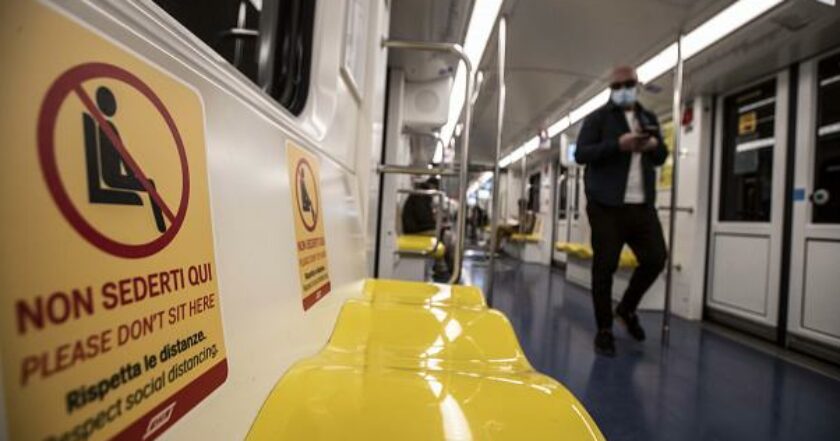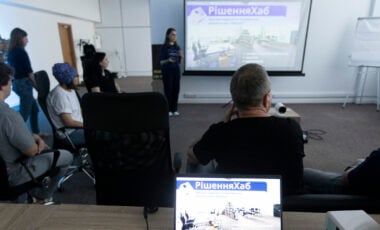Lockdown transit: how it was and what it led to

On May 22 2020 a two-month period during which public transit disappeared in the cities of Ukraine came to an end. An unprecedented case, which has not been seen in post-socialist history, but also in the last 77 years – since World War II. The so-called special transit came to take only the socially needed workers (such as healthcare workers or sellers) to their workplaces. By definition, it was not public, because the main principle of its work was excluded, which is also the name of the first type of public transport in history: omnibus ("for everyone" in Latin). The period of lockdown restrictions highlighted the disadvantages of 'manual' mobility management in cities, but it also opened the veil of important prospects and opportunities. Let's try to figure it out.
Stage 1. Strict lockdown
On March 18, all three metros in Ukraine (in Kyiv, Kharkiv and Dnipro) as well as metrotram in Kryvyi Rih were closed. The latter, however, resumes transportation after two days – from March 20. From March 23rd, all city public transit switched to the mode of special transit using special nominal passes, which were issued to employees of enterprises that ensure the life of cities. At the same time, in Kyiv, for unreasonable reasons, the number of routes was sharply reduced by 95% (from 310 to only 17). Two weeks later, the new network was replenished with two more routes, one of which brought people from housing estates to the closed metro station on the city's periphery (trolleybus 25). At the same time, in other cities with a population of over one million (plus Lviv), the suspension affected only a maximum of one third of routes, almost without affecting electric transit (trams and trolleybuses). This became possible when transferring even marshrutkas (jitneys) to the mode of special transit, as it was by the decree of the Cabinet of Ministers No. 211 of March 20 2020. Unlike Kharkiv, the capital did not introduce temporary ground transport routes duplicating metro lines, so 13 of 52 metro stations in Kyiv remained outside the coverage area of the special transit network.
Only 10 people were allowed to travel in one unit of rolling stock. This applied to both minibuses designed in peacetime for 40 passengers, and articulated trams with a capacity of 250-300 people. The exception was Vinnytsia, where the city council decided to allow 10 people per section of the vehicle (that is, up to 30 people in three-section Mirage or VinWay tram). Diametrically opposite to European practice, an unspoken rule was introduced to enter and exit vehicles only through the front door, which exposes the driver to a greater risk of infection, despite the fact that the pass can be checked by the conductor.

'Bohdan' tram in a non-standard place for it on Troieshchyna LRT line with a special route 28D, for the period of quarantine, the longest in Kyiv / Photo: transphoto.org (kV4dromax)
Fundamental changes also affected the frequency of transport, which are again typical only for the capital. The new traffic schedule template provided, with an official headway of 10 minutes at rush hour, the departs from the terminus for two rolling stock units at once once every 20 minutes. Thus, the real interval for passengers was 18-19 minutes. In other million-plus cities, the average route interval varies from 8 minutes in Odesa to 12 minutes in Dnipro. During this period, transport could well move without delay due to the almost complete absence of traffic jams. Notifications about traffic delays on the Kyivpastrans (Kyiv transit authority) Telegram channel were limited to an average of just two cases per day.
At this stage, transport services for the population in Kiev turned out to be the worst not only by the experience of locals, but also in comparison with other large cities of the country. There were 2 times less routes than in Dnipro, 2.5 times less than in Odesa or Lviv, and 6.7 times less than in Kharkiv. The number of stops, from which at that time it was possible to leave by special transit, became 25% less than in Kharkiv, only 4% more than in Dnipro, which is two times smaller than Kyiv in area.
Given the purely social function of such transportation in the context of city life support, some cities have abolished fares. So, Dnipro and Kryvyi Rih made all special transit free, and Lviv and Kharkiv – some temporary routes introduced during the lockdown (in particular, along the metro lines in Kharkiv). In Kyiv, conductors continued to work. Even the validators at closed urban rail stations were not turned off.
Stage 2. Transport collapse?
Easter, and then the May holidays, obviously pulled out the last lockdown savings from people and companies, so unofficially the economy began to revitalize. The people's mobility increased in comparison with the previous period, returning traffic jams to the capital. The lack of adequate special transit service threw wood on the fire, as can be seen from the daily estimates of traffic delays from A+S Ukraine according to TomTom.
Now the special transit, which had previously moved freely along the empty roads of the city, lost its speed. While in Berlin or Chisinau new and temporary dedicated public transit lanes were organized to improve its service, the frequency of movement was increased to provide a physical distance between passengers, in Kyiv, the city administration and transit authority were not able to adapt special transit under the conditions of this stage. The result is described above. Interestingly, according to Kyivpastrans, traffic delays of special transit remained at the same level – about two messages a day.
At this stage, passengers could travel in transit, occupying only up to half of the seats. However, the supply of such transportation remained weak – Lisovyi, Pechersk, Bortnychi, Mykilska Borshahivka, Myshelivka and Korchuvate, Zvirynets, DVRZ, Chervonyi Khutir, Novobilychi and Osokorky neighborhoods and housing estates were completely not covered by the network.
Stage 3. Easing lockdown. Ahead of the (re)launch of public transit
Since May 11, a number of enterprises have been allowed to work, and therefore the mobility of citizens has increased much more. According to traffic delays, traffic jams have broken all records for the same periods in previous years.
Kyivpastrans resumed operation of as many as three new routes (buses 20 and 33T and trolleybus 37A), two of which run from residential areas (Lisovyi and DVRZ) not to the city's business center or large public hubs, but to the closed metro stations. Thus, buses 114 and 118 going to the city center were on the verge of collapse, queues at stops became unseen since the transit crisis in Kyiv in 1993-95. Thus, in capital there wre 22 special transit routes, while Odessa has replenished its system with the renewal of twenty-two routes (primarily to the newly opened Pryvoz and Siomyi kilometr markets), increasing their total number to 66, and the number of operating stops became almost equaled the capital (521 against 530). Dnipro introduced a total of 89 special transit routes during this period. The service level of the special vehicles clearly correlates with the levels of delays in large cities, published by A+S Ukraine (https://bit.ly/3e52aZw):

Diagram by Tymofii Nahornyi / Some indicators are displayed in multiples for the possibility of a single scale
At the same time, the number of messages about traffic delays from Kyivpastrans increased 1.5 times on average to 2.9 messages per day.
Already in anticipation of the restart of public transit, on May 19, three more routes were resumed in Kyiv: two to the closed yet metro (buses 37 and 104) and one interdistrict (bus 42). Thus, the crowd on trolleybus 7 and bus 220, which run towards the city center, has increased. However, at the same time, the number of vehicles on the main routes was increased – headways at rush hour up to 4 minutes on tram route 1 and up to 5 minutes on bus routes 114 and 118 and trolleybus routes 91 and 92.

In Dnipro, the already not cut number of vehicles of special transit is being strengthened with restored articulated trolleybuses. Travel in this city is free during the lockdown restrictions / Photo: transphoto.org (Tor76)
On this stage, transport was allowed to carry passengers by the number of seats. Again, it does not correspond to the European practice, when half of the seats should still remain unoccupied, however, it is allowed to ride while standing.
One more problem is the rolling stock, which was provided for the work of special transit. Whether there are 123 serviceable buses and 195 trolleybuses of extra large capacity (18 m long) in Kyiv, large-capacity rolling stock (12 m long) was used to a greater extent, which caused queues at stops, especially during rush hour. As of May 20, the planned number of vehicles at rush hour for bus and trolleybus routes was 153 and 106 units respectively – so, it was possible to provide 80% of the buses output and all the trolleybuses with extra large capacity rolling stock. This is especially important in the context of ensuring the physical distance between passengers as one of the anti-epidemiological criteria. With trams, the situation became ridiculous, when, due to the rule of entering the front doors, the second cars of the couplings drove empty.

'Bohdan' trolleybus on the once night public, and during the quarantine – day special route 92N. The most commonly used is 12-meter rolling stock, despite the high demand / Photo: transphoto.org (tavalex2007)
Critics? Offers.
The special transit network has replaced the metro in cities such as Kyiv and Kharkiv. Its basis was the main radial routes that connected the outskirts of the city, in particular large residential areas, with the center, forming a transfer circuit. This period was supposed to be decisive in the formation of the main system of high-quality on-ground public transit, which would support the congested metro after the lockdown. At least, it would happen in a smart city that knows how to count traffic losses and has the political will to implement sustainable solutions rather than self-organizing transport genocide.
From the very beginning, there had to be some kind of tactics that the city would adhere to. Unfortunately, Kyiv does not have it even during the normal times. Back in 2015, World Bank experts developed a detailed plan to improve the public transit system in Kyiv. The result of its implementation over the five years is five new bus routes (two of which have magically become marshrutka instead of the convenient bus) and three new trolleybus routes. At the same time, the increase in the level of service was not observed enough, and bus 114, temporarily serving along the future metro line to Troieshchyna, usually stuck in traffic jams. Not surprisingly six of these new eight routes were chosen for special transit network.
The fact of the tram network divided into two parts also played a role. It is likely that if it were not separated after the reforms of Mayor Omelchenko in late 1990s and early 2000s rolling strategically important tramway lines into asphalt, this mode of transport would become the backbone of the on-ground transit network during lockdown restrictions due to its extremely high capacity, especially while using the multiple car trams.
Systems like MetroBus and MetroTram in Berlin or Select Bus Service in New York City have proven effective in supporting the metro, but not filling it with passengers. The recipe for good on-ground public transit is extremely simple: a clear timetables (every Kyiv resident knows that there is a headway of couple of minutes in the metro at rush hour, and just 10 minutes in the late evening), dedicated lanes and other priority measures, CCTV for violations by drivers of personal transport and inevitability of punishment for it. Unfortunately, this can only be organized if there is political will.
The Strategy for the development of Kyiv until 2025 clearly states the priority of public transit over personal. But who needs public transport that runs every 20 minutes and is stuck in traffic with cars?



























































